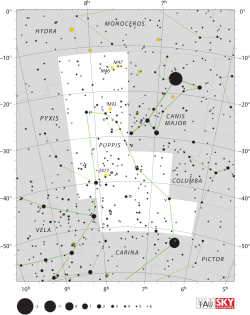HD 44594
HD 44594 är en ensam stjärna, belägen i den södra delen av stjärnbilden Akterskeppet. Den har en skenbar magnitud av ca 6,64[2] och kräver åtminstone en handkikare för att kunna observeras. Baserat på parallaxmätning inom Hipparcosuppdraget på ca 39,8[1] mas, beräknas den befinna sig på ett avstånd på ca 82 ljusår (ca 25 parsek) från solen. Den rör sig bort från solen med en heliocentrisk radialhastighet på ca 59 km/s.[4]
| HD 44594 | |
 | |
| Observationsdata Epok: J2000.0 | |
|---|---|
| Stjärnbild | Akterskeppet |
| Rektascension | 06t 20m 06,13530s[1] |
| Deklination | -48° 44′ 27,9344″[1] |
| Skenbar magnitud () | +6,64 (V)[2] |
| Stjärntyp | |
| Spektraltyp | G1.5 V[3] |
| U–B | +0,20[2] |
| B–V | +0,66[2] |
| Astrometri | |
| Radialhastighet () | +59,1[4] km/s |
| Egenrörelse (µ) | RA: +234,60[1] mas/år Dek.: -267,31[1] mas/år |
| Parallax () | 39,79 ± 0,34[1] |
| Avstånd | 82,0 ± 0,7 lå (25,1 ± 0,2 pc) |
| Absolut magnitud () | 4,56[4] |
| Detaljer | |
| Massa | 1,08[5] M☉ |
| Radie | 1,0[6] R☉ |
| Temperatur | 5 840[7] K |
| Metallicitet | +0,15(Fe/H)[7] dex |
| Vinkelhastighet | 4,4[8] km/s |
| Ålder | 4,1[5] miljarder år |
| Andra beteckningar | |
| CD-48 2259, CPD-48 833, FK5 2486, HIC 30104, HIP 30104, HR 2290, IRAS 06187-4842, NLTT 16414, PLX 1477, PPM 310646, SAO 217861, TD1 6911, uvby98 100044594, Gaia DR1 5553647078872137088 [9] | |
Egenskaper
redigeraHD 44594 är en gul[10] till vit stjärna i huvudserien av spektralklass G1.5 V.[3] vilket betyder att den genererar energi genom termonukleär fusion av väte i dess kärna. Den har en massa och en radie som är ungefär lika med solens[5][6] och en energiavgivning som är mycket lik solens vid en effektiv temperatur av ca 5 800.[7] K Den betraktas därför som en solliknande stjärna.[11] Överskottet av andra element än väte eller helium, vad astronomer kallar stjärnans metallicitet, är dock 41 procent högre än i solen.[12]
Referenser
redigera- Den här artikeln är helt eller delvis baserad på material från engelskspråkiga Wikipedia, HD 44594, 14 maj 2020.
Noter
redigera- ^ [a b c d e f] van Leeuwen, F. (November 2007), "Validation of the new Hipparcos reduction", Astronomy and Astrophysics, 474 (2): 653–664, arXiv:0708.1752, Bibcode:2007A&A...474..653V, doi:10.1051/0004-6361:20078357
- ^ [a b c d] Przybylski, A.; Kennedy, P. M. (1965), "Radial velocities and three-colour photometry of 166 southern stars", Monthly Notices of the Royal Astronomical Society, 131: 95–104, Bibcode:1965MNRAS.131...95P, doi:10.1093/mnras/131.1.95
- ^ [a b] Gray, R. O.; et al. (October 2003), "Contributions to the Nearby Stars (NStars) Project: Spectroscopy of Stars Earlier than M0 within 40 Parsecs: The Northern Sample. I.", The Astronomical Journal, 126 (4): 2048–2059, arXiv:astro-ph/0308182, Bibcode:2003AJ....126.2048G, doi:10.1086/378365
- ^ [a b c] Nordström, B.; et al. (May 2004), "The Geneva-Copenhagen survey of the Solar neighbourhood. Ages, metallicities, and kinematic properties of ˜14 000 F and G dwarfs", Astronomy and Astrophysics, 418 (3): 989–1019, arXiv:astro-ph/0405198, Bibcode:2004A&A...418..989N, doi:10.1051/0004-6361:20035959
- ^ [a b c] Sousa, S. G.; Fernandes, J.; Israelian, G.; Santos, N. C. (March 2010), "Higher depletion of lithium in planet host stars: no age and mass effect", Astronomy and Astrophysics, 512: L5, arXiv:1003.0405, Bibcode:2010A&A...512L...5S, doi:10.1051/0004-6361/201014125
- ^ [a b] Pasinetti Fracassini, L. E.; et al. (February 2001), "Catalogue of Apparent Diameters and Absolute Radii of Stars (CADARS) - Third edition - Comments and statistics", Astronomy and Astrophysics, 367: 521–524, arXiv:astro-ph/0012289, Bibcode:2001A&A...367..521P, doi:10.1051/0004-6361:20000451
- ^ [a b c] Sousa, S. G.; et al. (August 2008), "Spectroscopic parameters for 451 stars in the HARPS GTO planet search program. Stellar [Fe/H] and the frequency of exo-Neptunes", Astronomy and Astrophysics, 487 (1): 373–381, arXiv:0805.4826, Bibcode:2008A&A...487..373S, doi:10.1051/0004-6361:200809698
- ^ Schröder, C.; Reiners, A.; Schmitt, J. H. M. M. (January 2009), "Ca II HK emission in rapidly rotating stars. Evidence for an onset of the solar-type dynamo" (PDF), Astronomy and Astrophysics, 493 (3): 1099–1107, Bibcode:2009A&A...493.1099S, doi:10.1051/0004-6361:200810377
- ^ "LTT 2525 – High proper-motion Star", SIMBAD, Centre de Données astronomiques de Strasbourg, hämtad 2020-05-14.
- ^ "The Colour of Stars", Australia Telescope, Outreach and Education, Commonwealth Scientific and Industrial Research Organisation, December 21, 2004, archived from the original on March 10, 2012, hämtad 2012-01-16
- ^ Hardorp, J.; Tueg, H.; Schmidt-Kaler, T. (March 1982), "The sun among the stars. VI – The solar analog HD 44594", Astronomy and Astrophysics, 107 (2): 311–312, Bibcode:1982A&A...107..311H
- ^ For a metallicity of [Fe/H] = +0,15 dex, the proportion of heavier elements relative to the abundance in the Sun is given by: 10+0,15 = 1,4.



